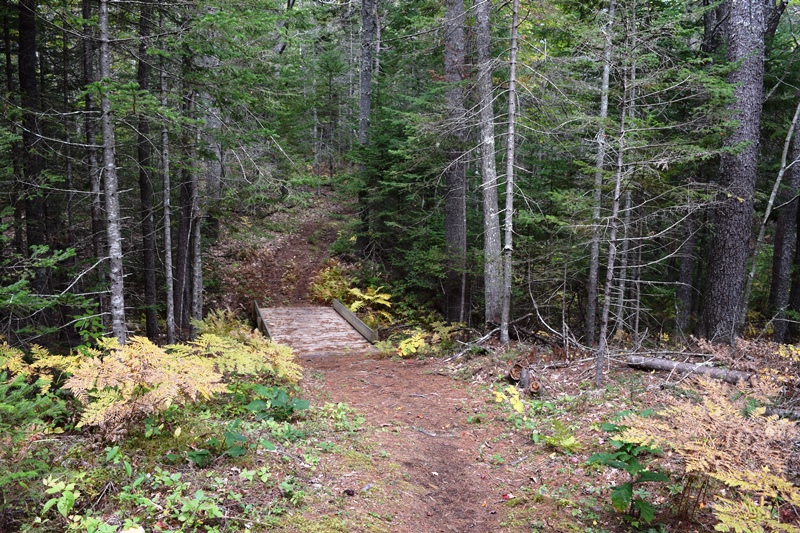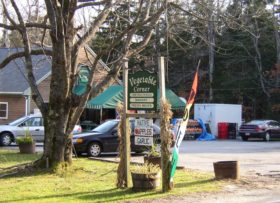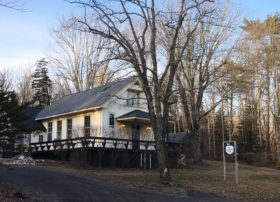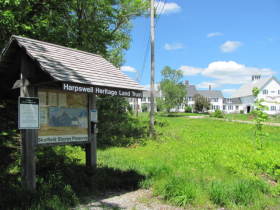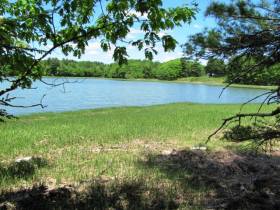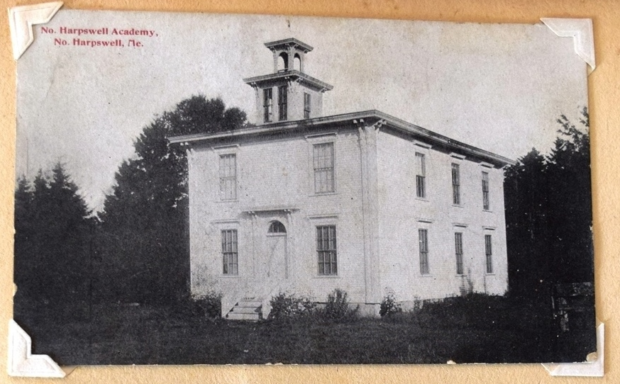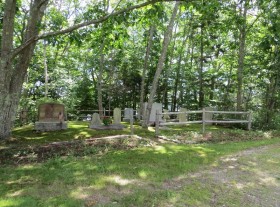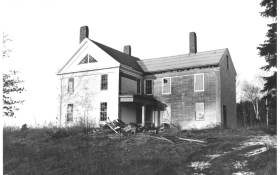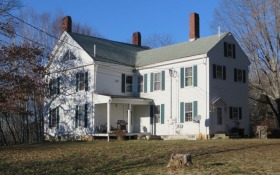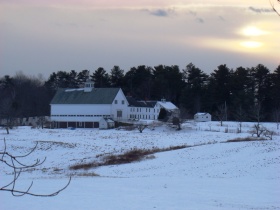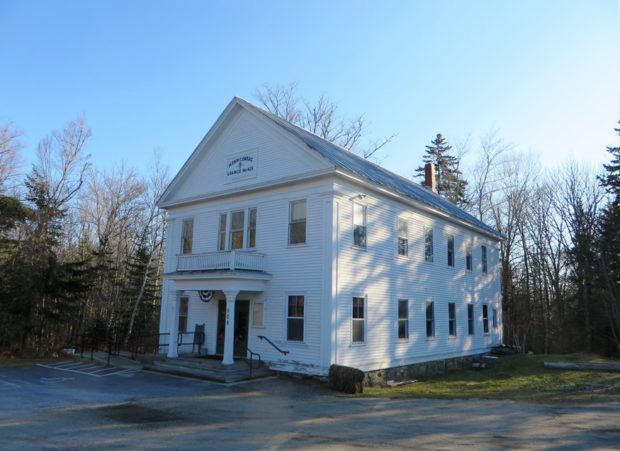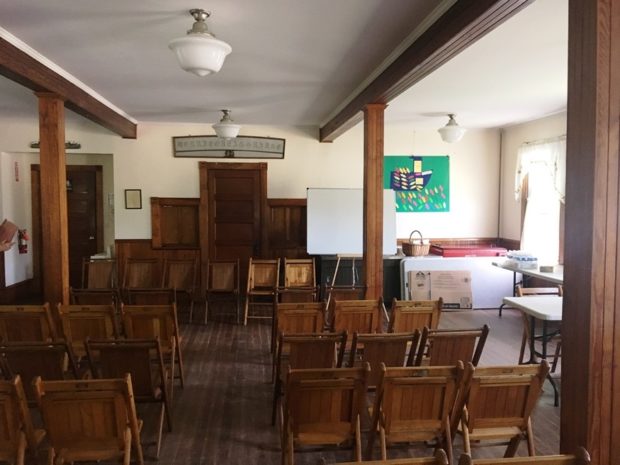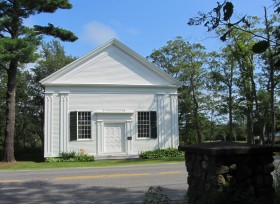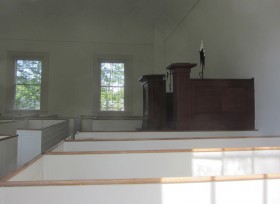In Harpswell, this is the northern most village on Harpswell Neck, the others being West and South Harpswell. It centers on the intersection of Route 123 from Brunswick and the Mountain Road, which links North Harpswell to the islands via the Ewing Narrows Bridge.
Near the intersection: the Merriconeag Grange, the Vegetable Corner grocery, a former school house frequently used as a restaurant. The Union Church is just south of the intersection.
The Harpswell Heritage Land Trust hold easements (Spruce Point, the Merrucoonegan Farm, and the Skolfield Shores Preserve, and Liberty Farm) providing protection to the historic Merrucoonegan Farm complex near the Brunswick town line.
The Land Trust’s Otter Brook Preserve, off Route 123, runs near one of the largest freshwater streams in Harpswell. This freshwater marsh, stream, and pond system is a scarce resource in this coastal community.
All-season trails meander through the forest providing about 1.5 miles of pleasant walking, cross country skiing and snowshoeing.*
Harpswell Academy
On June 13, 1859 the Harpswell Academy Corporation met in North Harpswell to begin their project to create an academy building. During the 18th and 19th centuries, at least fifteen towns had developed private academies.
 Harpswell Academy from Postcard provided by Harpswell Historical Society
Harpswell Academy from Postcard provided by Harpswell Historical Society
In addition to serving the town’s educational needs, the building was home to the Harpswell Coronet Band. The organization played at local events, but once went to Boston to participation in a “firemen’s muster.”
During the summer the late 19th and early 20th centuries the building was a classroom for the Portland High School Cadets. They held encampments near Wharf Road and often marched to the classroom in the Academy, much to the amusement of local residents.
The academy building, located next to the Grange Hall, burned to the ground on March 5, 1912.
[Image and text is courtesy of the Harpswell Historical Society.]
National Register of Historic Places – Listings
Dunning, Deacon Andrew, House
[off the Mountain Road, 0.6 miles southeast of junction with Maine Route 123 (on the Dunning Road)] The house was built in 1757-1760 for Deacon Andrew Dunning (1727-1808) shortly after he came to Harpswell during the French and Indian War. It is a two-story center chimney colonialstyle period frame dwelling that retains much of its original interior finish. Enlarged in the late nineteenth century after it passed out of the family, the house was extensively “restored” beginning in 1947 to what new owners believed was its 18th century appearance..It sits near the north shore of Harpswell Sound, a broad bay. Today a modern bridge spans the sound. In November of 2021 a bald eagle (below) arrived and roosted in the trees near the north shore, awaiting for food to be plucked from the water. 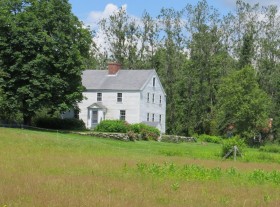
Prior to 1757, William Dunning of York, Andrew’s father, bought the land and gave it to him. Andrew was married with three children and apparently went immediately to Harpswell. He reportedly built a log cabin and lived in it for two years while he cleared the land, then built the house in 1760.
Andrew Dunning was prominent in town affairs as clerk for 23 years (1759-1782), selectman for four years and deacon of the First Parish Church for 41 years. His descendants lived on and farmed the land until 1871. Andrew may have owned the tide mill in nearby Mill Cove.*
Kellogg, Elijah, House
[off Maine Route 123 on Barton Lane] Located on a knoll overlooking Harpswell’s Middle Bay, the Elijah Kellogg House is a simple but distinctively designed Greek Revival dwelling. Built in 1849, the house was a home for Kellogg and his descendants until 1946. Nearly two decades of neglect and vandalism have been rectified. The west wall faces the ocean with four symmetrically arranged six-over-six windows on each of the two stories. The interior has survived in its original form.
The Kellogg House has retained its rather restrained but handsomely executed Greek Revival woodwork in every room. The chaste simplicity of this dwelling reflects the character of its original owner. Fortunately, the efforts of recent owners have indicated that it will be preserved as a tangible reminder of Kellogg’s religious and literary career.*
Merriconegan Farm
[Maine Route 123] This Farm is the most extensive and impressive example of extended or continuous architecture remaining in Maine and possibly New England. Well preserved, it comprises two complete houses with residential ells, sheds and two large barns, assembled between the early 1830’s and 1897.
On a rise overlooking Harpswell Cove, the Farm reflects the economic and cultural background of its builders.
Thomas Skolfield, son of a large Irish landholder, came to America in 1757 with the Orr family, later owners of Orr’s Island. Skolfield, a graduate of Oxford University, taught for a time at both Boston Latin School and Harvard College.
He acquired a large tract of land but had little time to develop it before his death in 1796. One of his sons, Clement, a Harvard graduate, remained on the land building a house (now in Brunswick a few hundred yards north) and working the farm.
Clement’s son George (known as “Master George”) then began a successful shipbuilding business on Cove across the road. The long series of large sailing vessels were often captained by his younger brothers.
“Master George,” with his father, built the first house in the complex and the older of the two barns. His son, George Roger, and grandson, Daniel T. built the remaining parts of the structure and continued the shipyard until the early years of the 20th century.*
Merriconeag Grange
 Merriconeag Grange (2014)
Merriconeag Grange (2014)
The 1918 Merriconeag Grange is a large two story wood frame building that continues to serve, as an important social and community center. Built by members of the Merriconeag Grange #425, established 1903, it was raised on the foundation of their former hall that burned in 1912. With a first-floor community room and kitchen and a large hall and stage on the second floor, the building provided an interior that supported Grange activities and other public events from town meetings to school graduations. The Grange corporation still owns the hall and continues to operate as a Grange and accommodates broader public events.
The Grange, or Patrons’ of Husbandry, was an important social organization across the country throughout the 19th and first half of the 20th century. It places particular emphasis on agricultural education and progressive community and social activities. The focus of the local Grange is community support and development.
Harpswell Grange Hall interior (2018)
Union Church
[Maine Route 123] This church is an important and virtually intact example of a towerless rural Maine religious building. Probably built in 1841 as a meetinghouse for the community of North Harpswell, the Union Church is a frame building that blends Greek Revival and Gothic Revival styles. On December 25, 1840, thirty people pledged to subscribe to pews if a meetinghouse containing forty pews was built.
On April 20, 1844, a Universalist Society was organized and apparently began to use the building for its services. By the mid-1870s the Universalists became inactive and the building was used for services by the Centre Congregationalist Society. In the early 1920s the building was closed and remained mostly vacant until 1969 when the Harpswell Garden Club began restoration.*
* See Additional resources in Harpswell.


